How To Calculate Clean Price Of A Bond In Excel
- Login
- Cart
- Training
- Videos
- Functions
- Formulas
- Shortcuts
- Blog
Excel PRICE Function
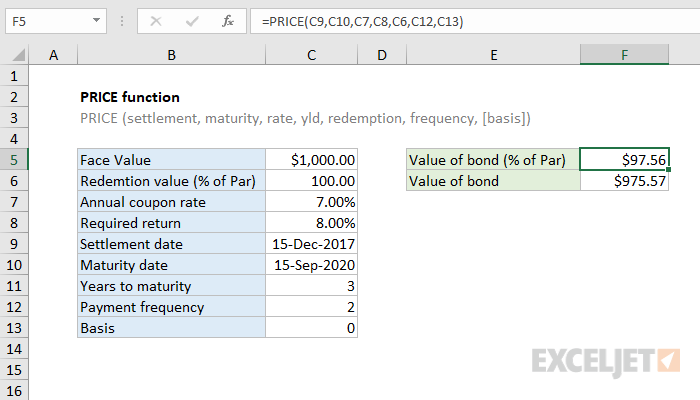
Summary
The Excel PRICE function returns the price per $100 face value of a security that pays periodic interest.
Purpose
Get price per $100 face value - periodic interest
Syntax
=PRICE (sd, md, rate, yld, redemption, frequency, [basis])
Arguments
- sd - Settlement date of the security.
- md - Maturity date of the security.
- rate - Annual coupon rate.
- yld - Annual required rate of return.
- redemption - Redemption value per $100 face value.
- frequency - Coupon payments per year (annual = 1, semiannual = 2; quarterly = 4.
- basis - [optional] Day count basis (see below, default =0).
Usage notes
The Excel PRICE function returns the price per $100 face value of a security that pays periodic interest. For example, the PRICE function can be used to determine the "clean price" of a bond (also known as the quoted price), which is the price of the bond excluding accrued interest.
In the example shown, the formula in F5 is:
= PRICE (C9,C10,C7,C8,C6,C12,C13)
with these inputs, the PRICE function returns 97.56, which indicates the value of the bond is 97.56% of the face value. To get the actual dollar value, the formula in F6 is:
Entering dates
In Excel, dates are serial numbers. Generally, the best way to enter valid dates is to use cell references, as shown in the example. If you want to enter valid dates directly inside a function, the DATE function is the best approach.
Basis
The basis argument controls how days are counted. The PRICE function allows 5 options (0-4) and defaults to zero, which specifies US 30/360 basis. This article on Wikipedia provides a detailed explanation of available conventions.
| Basis | Day count |
|---|---|
| 0 or omitted | US (NASD) 30/360 |
| 1 | Actual/actual |
| 2 | Actual/360 |
| 3 | Actual/365 |
| 4 | European 30/360 |
Notes
- In Excel, dates are serial numbers.
- settlement, maturity, frequency, and basis are truncated to integers
- If settlement or maturity dates are not valid, PRICE returns #VALUE!
- If basis is out-of-range, PRICE returns #NUM!
- If maturity date is not later than settlement date, PRICE returns #NUM!
Related functions
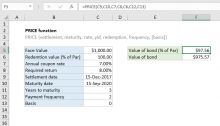
The Excel PRICE function returns the price per $100 face value of a security that pays periodic interest.
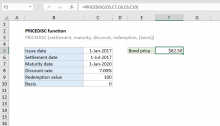
The Excel PRICEDISC function returns the price per $100 face value of a discounted security.
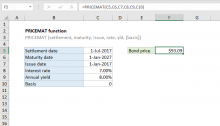
The Excel PRICEMAT function returns the price per $100 face value of a security that pays interest at maturity.
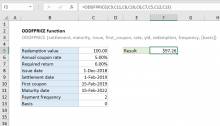
The Excel ODDFPRICE function returns the price per $100 face value of a security with an odd (irregular) first period.
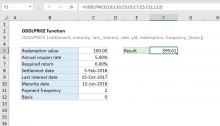
The Excel ODDLPRICE function returns the price per $100 face value of a security with an odd (irregular) last period.
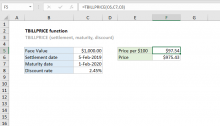
The Excel TBILLPRICE function returns the price per $100 face value for a Treasury bill.
Download 100+ Important Excel Functions
Get over 100 Excel Functions you should know in one handy PDF.
Excel video training
Quick, clean, and to the point.
Learn more
How To Calculate Clean Price Of A Bond In Excel
Source: https://exceljet.net/excel-functions/excel-price-function
Posted by: wenzelsymbeentere.blogspot.com

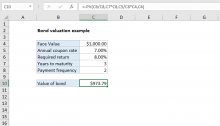
0 Response to "How To Calculate Clean Price Of A Bond In Excel"
Post a Comment